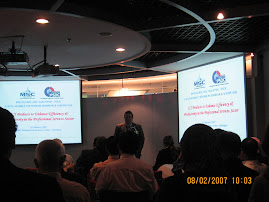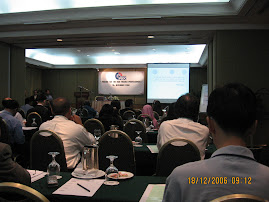Co-Agency Dispute: P vs. D (continuing from Part 3...)
P based her suit against D on just one written document dated on or around 4.1.2005 (Exhibit P-15) and not on another document dated 4.2.2005 (Exhibit P-16) or on a set of documents? Wouldn't the document dated 4.2.2005 (Exhibit P-16) a better document to rely on to base her suit if it was not a blank document as at the time of P filing of her suit? D believes the document dated 4.2.2005 was still a blank document as at the time of P's filing of her suit - that was why it was not relied on and filed as a completed document in the first filing of documents!
D's reasons in his letter dated 11/7/2006 - that the document dated 4.2.2005 could not be a valid co-agency contract - must have been convincing enough for P and her ilk not to rely on it as her basis of her claim. D had, through his letter dated 11.7.2006, detailed why the document dated 4.2.2005 could not be a valid co-agency agreement and P lawyers were aware of the reasons as the whole of this letter with all its attachments were also copied to P's lawyers when D replied to P's lawyers in Nov 2006.
Anyway, P and her ilk appeared to have 2nd thought about the document dated 4.2.2005: On 4.6.2010, the document was filed with the Court for the 2nd time - this time as a completed document (Exhibit P16, Pg. 5 Bundle F). Before this, it was filed as a photo-stated incomplete document with only the signature of Sharon DM for P's firm (Exhibit P-27 at Page 4 of Bundle E).
In the second filing, this document (Exhibit P-16) is an original document bearing D firm's letterhead, the signatures of both D and Sharon DM. This time the name and particulars of the bidder Y were filled-in it (Exhibit P16, Page 5 Bundle F). Fortunately, what was filled-in was not "ETM Sdn Bhd" - the eventual buyer of the 2 lands or "Y and/or approved nominee". What was filled-in was the name of Y and his particulars! Had it been filled in otherwise, D's defence would have been much much more onerous.
In A40 of P's Witness Statement: P claims that D admits that the letter dated 4/2/2005 (Exhibit P-27) is a "co-agency letter" in paragraph 2(i) of D's letter dated 11/7/2006. P was clearly quoting a part of D's letter out of the context of the whole letter. It is like you say: "I won't pay!" and they say you admit that you have to pay because you use the word pay in your sentence. What a flawed reasoning!
If indeed D admits that the letter dated 4.2.2005 is a co-agency agreement, why didn't P then base her suit on this letter dated 4.2.2005? Or, why didn't P base her suit on a string of documents including this letter dated 4.2.2005? Instead, she base her suit on just one written document dated on or around 4th January 2005 in Para 3 of her Statement of Claim (which is Exhibit P15)? Or, better still, why didn't P base her suit on the conduct of the parties?
P and her ilk knew that to base P's suit on the document dated on or around 4.2.2005 as a completed document would have been met outright by D with the allegation of fraud and that wouldn't made them looked nice right from the very beginning - so, they avoided that; and that to base her suit on conduct of the parties would have been met by D with the defence of breach by P of a fundamental implied term of "equal fees for equal sharing of risks and costs" in any co-agency contract because P was not forthcoming for a requested meeting with D on the service tax risk for about a year.
To D, the completed document dated 4.2.2005 is in fact a document not in existence as Court's document until 4.6.2010 (Friday) - that is, 1 working day before the trial began on 7.6.2005 (Monday). To D, it was only filed as an afterthought and an attempt to grab at any straw in an increasingly sinking case against D!
P cunningly tried via A21, A22 and A40 of her Witness Statement to amend her pleading by casting the basis of her claim wilder to include this document dated 4.2.2005 when Para 3 of her Statement of Claim, clearly and without a shadow of doubt, relies on one and only one written document dated 4.1.2005 as the contractual basis of her claim.
In testimony, when cross-examined by P's lawyer, D actually reasoned that if P's claim in Para 3 of her Statement of Claim was that there was a written co-agency contract on or around 4.1.2005, then why was there a need for another co-agency letter dated 4.2.2005? P lawyer's reply was that it was because D wanted to introduce an amendment, an additional term to the earlier agreement. If so, doesn't that mean that there is no finality of terms in the earlier agreement dated on or around 4.1.2005? (And so, the written contract which P based her suit on need not be performed by both parties under Section 63 of the Contracts Act?)
D's defence on issues of facts and law, among others, are essentially that: How could there be a written co-agency contract on or around 4.1.2005 involving the 2 parcels of lands for sale by tender (as described in Para3 and Para 2.2 of P's Statement of Claim and A15 of P's Witness Statement):
1) when on or around 4.1.2005, the 2 parcels of lands were still not known or available to D and other panel agents for sale by tender yet (a marked exhibit at Page 12 Bundle E was adduced to prove this)? When features in the document itself suggest that it was not about the 2 parcels of lands - no mention of the codes of the lands, nothing on tendering process, no mention of the lands as D client's lands for sale by tender (Exhibit P15, Pg. 2 Bundle E), singular "Land" and not plural "Lands" was used in the heading, etc.? When evidence adduced by P itself proves that M enquired about the 2 parcels of lands only towards 31.1.2005 (a marked exhibit at Pages 5-6 of Bundle B)? So, how could there be an agreement on the 2 parcels of lands even before enquiry on them?
2) when the document itself clearly shows that it was signed by a Sharon DM who was not a registered estate agent at all the material times, thereby contravening Rule 102 of the VAEA Rules, Circular 2/97, Rule 110 of the VAEA Rules; and is null and void under Sections 11 & 10 of the Contracts Act?
3) when there was no absolute and unqualified acceptance by D of the fee-sharing proposal from Sharon DM of P's firm under Section 7 of the Contracts Act?
4) when there was no evidence of acceptance, by P or any REA capable of representing P, of D's qualified acceptance or signed counter-proposal?
5) when the document itself has on its face the illegal object of trying to collect fee from party other than from P firm's own client -- in contravention of Rule 89 of the VAEA Rules, thereby rendering it null and void as a contract under Sec 24 of the Contracts Act?
6) when evidence adduced by P herself in the form of co-agency letters dated 4.2.2005 shows that even if the document dated 4.1.2005 was about the 2 parcels of lands which D denied it was, its terms of were not finalised or need not be performed under Section 63 of the Contracts Act?
D's defence from the time he filed his "Notis Kehadiran" to the time of completion of trial has been consistent: that the document dated on or around 4.1.2005 which P based her suit on in Para 3 of her Statement of Claim, is null and void, and unenforceable as a contract.
D's case is: that P's case against D was based purely on blatant lies, cooked-up stories, irrelevant documents and an intimidating show of connections and powers; that it was a suit without any merits whatsoever; that P has not proven her legal standing under S22C(1)(d) and S23 of the VAEA Act 1981 for this suit against D; that P has no cause of action because prior to this suit, there was never any valid claims forwarded by P to D for co-agency fee; and that this suit is clearly frivolous, vexatious and an abuse of the process of the Court.
More on this dispute in Part 5...stay tuned!
A blog on Malaysian real estate agency law & practice; property & marketing issues. Anchored and authored by Mr. Douglas GT Tan -- a Malaysian real estate agent registered with the Board of Valuers, Appraisers & Estate Agents of Malaysia since 2000. Comments are welcome but must be posted in the "comments" section of the post to receive reply! All posts may be shared online elsewhere provided the URL of the post or this blog is published too. Have fun.
Read In Your Language
Useful Links Here:
- Malaysian PM's "1Malaysia" Website
- EPU Guideline (formerly FIC) on Acquisition of Properties (wef 1 Jan 2010) by Foreigners
- FIC Disbanded on 30.6. 2009 - The Star
- Selangor Regulations (wef 10 Dec 2009) on Acquisition of Selangor Residential Properties by Foreigners
- Johor Regulations (Pekeliling 1/2009, etc.) on Acquisition of Johor Properties by Foreigners
- Penang Regulations on Acquisition of Penang Properties by Foreigners
- Malaysia My 2nd Home Programme
- Real Estate Agency Career
Expand the Memory:
Govt-Sponsored Capacity-Building Talks for Professionals

At Cyberjaya, Malaysia.
Capacity Building Seminar for Professionals

At Cyberjaya, Malaysia
"Finance for Non-Finance Professionals"

A Talk by A Corporate Bigwig, Legend Hotel, KL








No comments:
Post a Comment